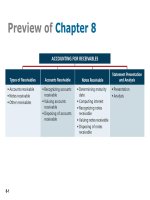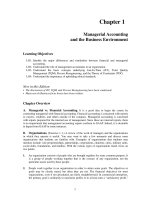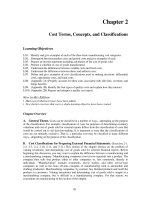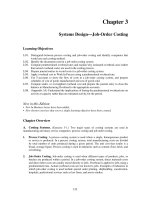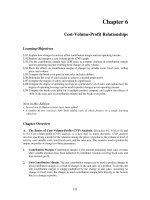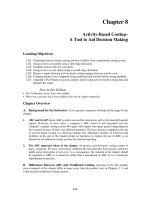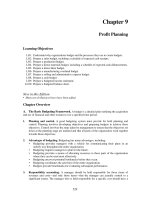Overview managerial accounting chapter 08
Bạn đang xem bản rút gọn của tài liệu. Xem và tải ngay bản đầy đủ của tài liệu tại đây (2.48 MB, 82 trang )
Chapter 8
Activity-Based Costing–
A Tool to Aid Decision Making
Learning Objectives
LO1.
LO2.
LO3.
LO4.
LO5.
LO6.
LO7.
Understand activity-based costing and how it differs from a traditional costing system.
Assign costs to cost pools using a first-stage allocation.
Compute activity rates for cost pools.
Assign costs to a cost object using a second-stage allocation.
Prepare a report showing activity-based costing margins from an activity view.
Compare product costs computed using traditional and activity-based costing methods.
(Appendix 8A) Prepare an action analysis report using activity-based costing data and
interpret the report.
New in this Edition
• New In Business boxes have been added.
• Many new exercises have been added to the end of chapter materials.
Chapter Overview
A. Background for the Instructor. A few general comments will help set the stage for the
chapter.
1.
ABC and GAAP. Some ABC systems are used for external as well as for internal financial
reports. However, in most cases, a company’s ABC system is not integrated with the
company’s regular costing system. We agree with experts who argue against integrating the
two systems because of their very different purposes. We have chosen to emphasize the use
of activity-based costing as a decision-making tool, although a number of exercises and
problems at the end of the chapter permit an instructor to explore the use of ABC as an
alternative to traditional costing systems for external reporting.
2.
The ABC approach taken in the chapter. In practice activity-based costing comes in
many variations. We have consciously combined the best elements from practice and have
added some innovations of our own. As a consequence, the material in the chapter should
be regarded as ABC as it should be rather than a description of ABC as it is commonly
implemented in practice.
B. Differences Between ABC and Traditional Costing. (Exercise 8-16) The product
costs computed in this chapter differ in major ways from the product costs in Chapters 2, 3, and
4 that describe traditional costing systems.
448
1.
Manufacturing costs in ABC. In the ABC system described in the chapter, some
manufacturing costs are excluded from product costs. This treatment follows
recommendations by Cooper and Kaplan and others.
a. The chapter advocates excluding the costs of idle capacity from product costs, but
without getting into the details of how this is done. It would be helpful, but not
absolutely necessary, for your students to have read Appendix 3A, which goes into this
subject in greater depth.
b. We also exclude organization-sustaining costs from activity-based costing product
costs. These costs will be discussed in more detail below. Basically, organizationsustaining costs are excluded from product costs because they are not caused by
individual products and are not relevant in decisions concerning those products.
2.
Non-manufacturing costs in ABC. Strictly speaking, non-manufacturing costs are
excluded from product costs under GAAP. However, to the extent that these costs are
caused by specific products, excluding them results in misleading information for making
decisions. It is true that these non-manufacturing costs can be deducted from product
revenues in addition to unit product costs when decisions are made, but this is not always
done. It is probably safer to build these costs right into product costs, which is the approach
taken in this chapter. (Remember, these costs are to be used for making decisions, not
valuing inventory and cost of goods sold.)
3.
Multiple overhead cost pools in ABC. Traditional overhead costing systems are described
in Chapters 2, 3, and 4. In these traditional systems, an entire plant may have a single
overhead cost pool or each production department may have a separate overhead cost pool.
In nearly all cases, overhead costs are applied to products using either direct labor-hours,
direct labor cost, or machine-hours. In activity-based costing, each major activity has its
own separate overhead cost pool. An activity is any event that causes the consumption of
resources. The activities tracked in the ABC system may cut across many departments and
the measures of activity (i.e., allocation bases) may be quite different from the traditional
allocation bases.
C. Cost Hierarchy in Activity-Based Costing. (Exercises 8-8, 8-13, and 8-15.)
Thousands of activities are carried out in most organizations. It would not be practical to track
all of them in an activity-based costing system. A great deal of simplification is necessary.
Activities and their costs must be combined to reduce complexity and record-keeping
requirements. One way to simplify is to group activities into a hierarchy. Activities, and their
costs, can be combined within each level of the hierarchy into activity cost pools—hopefully
with minimal loss in accuracy. The cost hierarchy used in the text is not the only scheme that
could be used, but it is reasonably comprehensive. The levels in the hierarchy are as follows:
1.
Unit-level activities. These activities are performed each time a unit is produced. For
example, providing power to run processing equipment is likely to be a unit-level activity.
2.
Batch-level activities. These activities are performed each time a batch is handled or
processed, regardless of how many units are in the batch. For example, tasks such as
placing purchase orders, setting up equipment, and arranging for shipments to customers
are batch-level activities.
449
3.
Product-level activities. These activities relate to specific products and must be carried out
regardless of how many batches or units of product are produced or sold. For example,
designing a product, advertising a product, and maintaining a product manager and staff are
all product-level activities.
4.
Customer-level activities. These activities relate to specific customers and include sales
calls, catalog mailings, and general technical support not tied to any specific product.
5.
Organization-sustaining activities. These activities are carried out regardless of which
products are produced, how many batches are run, or how many units are made. This
category of activities includes cleaning executive offices, providing a computer network,
arranging for loans, preparing annual reports to shareholders, and so on.
D. Mechanics of Activity-Based Costing. (Exercises 8-9, 8-10, 8-11, 8-18, 8-20, and 816.) Exhibit 8-6 is a useful Exhibit for summarizing the mechanics of activity-based costing.
You may want to refer to it frequently as you walk students through the steps of assigning costs
using ABC.
1.
Overview. Once the activity cost pools and their activity measures have been defined, costs
are allocated to the activity cost pools. The costs in the activity cost pools are then divided
by their activity measures to determine activity rates. (Activity rates are like the overhead
rates of Chapter 3.) The activity rates are then used to assign costs to cost objects such as
products and customers. For example, if a customer generates five orders and the activity
rate for orders is $15 per order, then the customer would be assigned $75 in order costs.
The mechanics are fundamentally no different from the mechanics covered in Chapter 3 for
applying overhead to products. The main difference is that instead of one predetermined
overhead rate, many activity rates are used.
2.
First-stage allocations. (Exhibits 8-13, 8-15, and 8-9.) The first stage in the allocation
process is based on a table showing the distribution of resource consumption across
activities for each category of cost in the company’s bookkeeping system. For example, if
indirect factory wages is one of the accounts in the company’s bookkeeping system, the
table would show what percentage of indirect wages is attributable to each of the activities
in the company’s ABC system. The text describes how interviews can be used to elicit
these percentage distributions, but these percentage distributions are always given in all
examples and problems.
The first-stage allocation is accomplished by multiplying the total cost of each account by
the percentages in its row in the table showing the distribution of resource consumption
across activities. For example, if the table shows that 20% of indirect factory wages are
attributable to processing batches, then 20% of the cost of indirect factory wages would be
allocated to that activity cost pool.
The end product of the first stage of the allocation process is a table showing how each cost
such as indirect factory wages is divided up among activity cost pools.
3.
The “Other” activity cost pool. In the text one activity cost pool is usually labeled
“Other.” Costs are allocated to this activity cost pool in the first stage of the allocation
process but they are not subsequently allocated to products, customers, or other cost
objects. This activity cost pool is supposed to capture costs of idle capacity and
organization-sustaining costs that should not be allocated to cost objects because they are
not caused by the cost objects. In practice, these costs are almost always allocated to cost
450
objects—the costs of idle capacity and organization-sustaining costs are seldom segregated
from other costs.
4.
Computation of activity rates. (Exhibit 8-5.) The total cost assigned to an activity cost
pool in the first-stage allocation is divided by the total amount of activity for the cost pool
to determine the activity rate for that cost pool. Each activity cost pool has its own activity
rate.
5.
Second-stage allocations of costs to cost objects. (Exhibit 8-8.) The activity rates can be
used to assign costs to any cost object. The activity rate is simply multiplied by the amount
of activity for the cost object.
6.
Product and customer margins—activity view. (Exhibit 8-9) Margins for products,
customers, and other cost objects can be easily constructed using the costs in Exhibit 8-8.
These costs are combined with whatever costs are directly traced to the cost object (for
example, direct materials), and deducted from the sales attributable to the cost object. This
is the conventional approach in activity-based costing.
E. Activity Rates and Activity-Based Management. (Exercise 8-10.) Activity rates (i.e.,
the cost per unit of activity) can be useful to managers in targeting business process
improvements. If activity rates are available from other organizations, an unusually high cost for
carrying out a particular activity can signal room for improvement. Also, if similar activities are
carried out at different locations within the same organization, activity rates can help identify
which locations are most efficient. The methods used at the most efficient locations can then be
applied to other locations.
F.
The Impact on Product Costs of Adopting an ABC System. (Exercise 8-21.) Unit
product costs are different under activity-based costing and traditional cost systems for a number
of reasons. First, some manufacturing costs (i.e., the costs of idle capacity and organizationsustaining costs) are excluded from product costs under the activity-based costing approach
described in the text. Second, some non-manufacturing costs are included in product costs under
activity-based costing. These two differences affect the total amount of cost allocated to
products. However, even if these differences are ignored or suppressed, the unit product costs
will still differ between activity-based costing and traditional costing systems. For example, if a
company switches to activity-based costing for external financial reports, the total costs
allocated to products will remain the same, but the pattern of allocation will differ.
The biggest changes in product costs from switching to an ABC system occur when the
ABC system includes batch or product-level costs. In this case, costs ordinarily shift from highvolume products to low-volume products. Consequently, the total and per unit costs of the highvolume products decrease and the total and per unit costs of the low-volume products increase.
When overhead costs are shifted from one product to another, a given dollar amount is implicitly
subtracted from the total cost of one product and added to the total cost of the other product.
Since the total cost of all products remains the same, what is taken away from one product must
be added to another product. However, the effects on unit costs are not symmetrical. The perunit costs of the low-volume products must go up more than the per-unit costs of the highvolume products go down.
G. Appendix 8A: ABC Action Analysis. (Exercises 8-12, 8-19, and 8-21) The
conventional ABC analysis discussed in the chapter has some important drawbacks for
decision-making. Most importantly, with a product margin analysis such as the one shown
451
in Exhibit 8-9, it is unclear who is actually responsible for a cost. For example, if a product
is dropped because of a negative margin, it is unclear who would be responsible for
actually carrying out reductions in costs. An activity cost pool may contain costs from
many departments. If a product is dropped, the activities associated with the product will
presumably disappear, but will the costs? If it is unclear who would be responsible for
reducing the costs, no one may actually take any action. This is particularly true for
personnel costs. What manager will voluntarily give up personnel if there is no
accountability?
Be sure to reinforce the idea that the costs assigned to a product, customer, or whatever in
an activity-based costing system are relevant in a decision only if the costs would actually
change if the decision were taken. For example, in a product drop decision, the costs of
resources are relevant only if spending would decrease as a result of the decision or the
resources would be redeployed to more profitable uses. In the latter case, this means that
the resources would have to be redeployed to the constraint.
An action analysis report makes it much clearer what costs are likely to be relevant in a
decision and who in the organization would be responsible for the cost if an action is taken.
Unfortunately, preparing an action analysis report requires considerably more work than
the more conventional analysis.
1.
Activity rates. (Exhibit 8A-2) The action analysis approach differs from the conventional
ABC approach beginning with the computation of the activity rates. In the conventional
analysis, a single activity rate is computed for each activity cost pool. In an action analysis,
a rate is computed for each cost category within an activity cost pool. Looking at Exhibit
8A-2, only the rates at the bottom of the Exhibit would be computed in a conventional
analysis. In an action analysis, the entire table is filled out.
2.
Second-stage allocations. (Exhibit 8A-3) In an action analysis, an entire matrix of costs is
computed rather than just a total cost for each activity cost pool. Looking at Exhibit 8A-3,
only the costs at the bottom of the Exhibit would be computed in a conventional analysis.
In an action analysis, the entire table is filled out by multiplying activities by the activity
rates in each cell.
3.
The conventional activity analysis. From the action analysis cost matrix in Exhibit 8A-3,
it is easy to construct the conventional activity analysis report showing product margins.
Just take the totals from the bottom of the cost matrix. Note that these costs are identical to
the costs computed earlier in the chapter in Exhibit 8-8.
However, using the row totals from Exhibit 8A-3, it is possible to look at the margins of
products and other cost objects from a different perspective. Instead of abstract labels like
“order processing costs” for the various activity cost pools, the costs are labeled using the
account titles from the company’s bookkeeping system. This makes it clear what the costs
actually consist of and who in the organization would be responsible for taking action if a
decision is made.
4.
Ease of adjustment codes. (Exhibit 8A-4) Some costs, such as direct materials, are much
easier to adjust than other costs, such as the total wages of experienced supervisors. As a
consequence, some costs are more likely to be relevant in a decision than others. The ease
of adjustment codes provide a way of assisting managers in making these distinctions.
a. Green. These costs adjust automatically to changes in activity without any
management action. Examples include direct materials and the cost of power to run
machines.
452
b. Yellow. These costs could, in principle, be adjusted to changes in activity, but
management action would be required. Direct labor is usually such a cost, as are many
discretionary expenses.
c. Red. These costs would be very difficult to adjust to changes in activity and
management action would be required. Examples include time-based depreciation and
many salaries.
5.
Action analysis report. (Exhibit 8A-5) The action analysis report combines the cost
information from the row totals in Exhibit 8A-3 with the ease of adjustment codes in
Exhibit 8A-4. This report makes it much clearer where costs would need to be adjusted in
the organization as the result of an action, who would be responsible for the change in
costs, and which costs are likely to be relevant and which costs are likely to be irrelevant in
decisions. Such an action analysis report is not the final step in the decision-making
process. Further analysis, such as illustrated in Chapter 13, would be necessary before
making any major decision.
453
Assignment Materials
Assignment
Exercise 8-1
Exercise 8-2
Exercise 8-3
Exercise 8-4
Exercise 8-5
Exercise 8-6
Exercise 8-7
Exercise 8-8
Exercise 8-9
Exercise 8-10
Exercise 8-11
Exercise 8-12
Exercise 8-13
Exercise 8-14
Exercise 8-15
Exercise 8-16
Exercise 8-17
Exercise 8-18
Exercise 8-19
Exercise 8-20
Exercise 8-21
Problem 8-22
Problem 8-23
Problem 8-24
Problem 8-25
Problem 8-26
Problem 8-27
Problem 8-28
Problem 8-29
Problem 8-30
Case 8-31
Case 8-32
Case 8-33
Case 8-34
Level of
Topic
Difficulty
ABC cost hierarchy ..................................................................
Basic
First-stage allocation ................................................................
Basic
Compute activity rates .............................................................
Basic
Compute ABC product costs....................................................
Basic
Product and customer profitability analysis .............................
Basic
Contrasting traditional and ABC product costs........................
Basic
(Appendix 8A) Preparing an action analysis report .................
Basic
Cost hierarchy. .........................................................................
Basic
First-stage allocations ..............................................................
Basic
Computing and interpreting activity rates................................
Basic
Second-stage allocation to an order .........................................
Basic
(Appendix 8A) Second-stage allocation to an order using
the action analysis approach................................................
Basic
Activity measures.....................................................................
Basic
Computing ABC product costs ................................................
Basic
Cost hierarchy and activity measures.......................................
Basic
Calculating and interpreting activity-based costing data .........
Basic
Activity-based costing as an alternative to traditional
product costing ....................................................................
Basic
Second-stage allocation and margin calculations.....................
Basic
(Appendix 8A) Second-stage allocation and margin
calculations using the action analysis approach ..................
Basic
Comprehensive activity-based costing exercise.......................
Basic
(Appendix 8A) Comprehensive activity-based costing
exercise................................................................................
Basic
Activity-based costing as an alternative to traditional
product costing .................................................................... Medium
(Appendix 8A) Activity rates and activity-based
management ........................................................................ Medium
Evaluating the profitability of services .................................... Medium
(Appendix 8A) Evaluating the profitability of services using
an action analysis approach................................................. Medium
Activity-based costing as an alternative to traditional
product costing .................................................................... Medium
Activity-based costing and bidding on jobs ............................. Medium
Second-stage allocations and product margins ........................ Medium
(Appendix 8A) Second-stage allocations and product
margins................................................................................ Medium
Activity-based costing as an alternative to traditional
product costing .................................................................... Medium
Activity-based costing and pricing........................................... Difficult
Contrasting activity-based costing and traditional costing ...... Difficult
(Appendix 8A) Comprehensive activity-based costing case.... Difficult
Activity-based costing as an alternative to traditional
product costing .................................................................... Difficult
454
Suggested
Time
10 min.
15 min.
10 min.
10 min.
30 min.
30 min.
20 min.
10 min.
10 min.
20 min.
10 min.
30 min.
10 min.
20 min.
15 min.
30 min.
45 min.
15 min.
45 min.
30 min.
60 min.
60 min.
45 min.
45 min.
75 min.
60 min.
45 min.
20 min.
30 min.
45 min.
90 min.
90 min.
120 min.
90 min.
Essential Problems: Problem 8-22 or Problem 8-26, Problem 8-24, Problem 8-27, Problem 8-28
Supplementary Problems: Problem 8-30, Case 8-31, Case 8-32, Case 8-34
Linked Exercises: Exercise 8-10 should be assigned only if Exercise 8-9 is also assigned.
Exercise 8-12 should only be assigned if Exercise 8-11 is assigned.
Appendix 8A Essential Problems: Problem 8-23, Problem 8-25, Problem 8-29
Appendix 8A Supplementary Problems: Case 8-33
455
1
2
456
3
Chapter 8
Lecture Notes
Helpful Hint: Before beginning the lecture, show
students the seventh and eighth segments from the
second tape of the McGraw-Hill/Irwin Managerial/Cost
Accounting video library. These segments introduce
students to many of the concepts discussed in chapter 8.
The lecture notes reinforce the concepts in the video.
1
Chapter theme: This chapter introduces students to
activity-based costing (ABC) which is a tool that has
been embraced by a wide variety of service,
manufacturing, and non-profit organizations.
2
ABC is a costing method that is designed to provide
managers with cost information for strategic and other
decisions that potentially affect capacity and therefore
“fixed” as well as variable costs. It is ordinarily used as a
supplement to, rather than as a replacement for, the
company’s usual costing system.
I.
How costs are treated under activity-based costing
A. “Best practice” ABC differs from traditional cost
accounting in five ways:
i.
ABC assigns both manufacturing and
nonmanufacturing costs to products.
Traditional cost systems only assign
manufacturing costs to products.
3
1. For example, ABC systems can assign sales
commissions, shipping costs, and warranty
repair costs to specific products.
457
4
5
458
ii.
ABC systems do not assign all
manufacturing costs to products, while
traditional cost systems do assign all
manufacturing costs to products.
4
1. This is because ABC only assigns a cost to a
product if decisions concerning that product
will cause changes in the cost.
Helpful Hint: Emphasize that ABC systems that are
used to support internal decision making do not need to
conform to GAAP. Therefore, while GAAP requires
treating S, G & A as a period expense and it requires
assigning all manufacturing costs to products, ABC
systems can assign S, G & A expenses to products and
they can exclude manufacturing costs from product
costs where appropriate.
iii.
5
ABC uses more cost pools than traditional cost
systems which often use a single plantwide
overhead pool or just one overhead pool per
department.
1. ABC cost pools are created to correspond to
the activities performed in an organization
that cause the consumption of overhead
resources.
a. The total number of ABC cost pools
will definitely exceed one (as in the
plantwide approach) and it is likely to
exceed the number of departments
within a company (as in the
departmental approach) since more
459
5
460
5
than one activity is often performed
within each department.
“In Business Insights”
The insights revealed by creating a larger number of
cost pools as in an ABC system can change the focus of
a manager’s attention. For example:
“ABC Changes the Focus” (page 317)
• Euclid Engineering makes parts and components
for automobile manufacturers. As a result of its
ABC study, its managers realized that the
company was spending more on launching new
products than on direct labor expenses to produce
existing products.
• Product development and launch expenses were
10% of expenses whereas, direct labor costs were
only 9%. Rather than focusing on reducing direct
labor costs, managers turned their attention to
reducing product launch costs.
• Euclid’s ABC information was shared with
customers who used the detailed breakdown of the
costs of design and engineering activities to
compare the cost of product design features with
the increase in functionality offered by those
features.
“Peddling to Oblivion” (page 319)
• Claudia Post started a small bicycle-messenger
service, Diamond Courier, in Philadelphia. Her
business eventually expanded to include truck
deliveries, airfreight services, a parts-distribution
division, and a legal service that served
subpoenas and prepared court filings.
461
6
7
462
8
• Within three years Diamond was booking $3.1
million dollars in annual sales and had 40 bike
messengers, an office staff of 25 employees, and
about 50 independent drivers. However, the
company was losing money!
• An ABC analysis revealed that the average cost of
a bike delivery, including overhead, was $9.24,
but she was charging only $4.60. She decided to
drop the bicycle messenger service and
concentrate on other profitable lines of business.
• Further analysis later led to closing down the
airfreight and parts-distribution divisions. Today,
13 years after making its first local messenger
delivery, the company now known as the Diamond
Transportation Group is a leading national
provider of transportation logistics management.
iv.
6
7
8
ABC uses more allocation bases than
traditional cost systems which rely solely on
volume as the base for allocating overhead
costs.
1. The most common allocation bases in
traditional cost systems are direct labor
hours and machine hours.
a. These bases work correctly when
changes in the quantity of the base are
correlated with changes in the
overhead costs being assigned using
the base.
b. Relying exclusively on these bases to
assign overhead costs to products has
come under increased scrutiny since,
on an economywide basis, direct labor
and overhead costs have been moving
463
8
9
464
8
9
in opposite directions and the variety
of products produced by companies
has increased.
2. ABC systems often use direct labor hours,
machine hours, or other unit-level allocation
bases to assign the portion of overhead costs
that move in tandem with the volume of
production. However, unlike traditional
systems, ABC also uses additional allocation
bases that are not related to the volume of
production to assign overhead costs that are
not correlated with volume.
“In Business Insights”
ABC systems usually include a larger number of
allocation bases than traditional cost systems. For
example:
“Shedding Light on Product Profitability” (page 315)
• Reichhold, Inc., a leading supplier of synthetic
materials, adopted ABC to shed light on the
profitability of its various products.
• Reichhold’s prior cost system used one allocation
base, reactor hours, to assign overhead costs to
products.
• The ABC system uses four additional activity
measures – preprocess preparation hours, thintank hours, filtration hours, and waste disposal
costs per batch – to assign overhead costs to
products.
• Reichhold has rolled out ABC to all 19 of its
North American plants to help improve decision
making.
465
10
11
466
v.
1. Using the budgeted level of activity to
compute a predetermined overhead rate
results in unused capacity costs being
assigned to products.
2. Using activity capacity to compute
predetermined overhead rates isolates
unused capacity costs as a period expense
rather than assigning them to products.
10
II.
ABC systems may base the level of activity for
each cost pool on the capacity of the activity
rather than the budgeted level of activity
which is always used in traditional cost
systems.
Designing an activity-based costing (ABC)
system
A. Characteristics of a successful ABC
implementation:
i.
There should be strong top management
support.
1. Without leadership from top management,
some managers may not see any reason to
change.
2. Without top management support, the ABC
implementation will be seen as unimportant.
11
ii.
There should be cross-functional
involvement.
1. Since ABC affects people across
departments, it should involve these people
467
11
12
468
and be fully supported by them. If the
accounting department alone attempts to
impose ABC on others, skepticism and
resistance are inevitable.
2. A well designed ABC system requires
intimate knowledge of many parts of an
organization. This knowledge can only be
learned from employees familiar with the
various parts of an organization’s
operations.
11
iii.
ABC data should be linked to how people are
evaluated and rewarded.
1. If traditional non-ABC data continues to be
used to evaluate employee performance, it
sends the signal that ABC data is
unimportant and can even be ignored.
B. The activity-based costing model
i.
Cost objects such as products generate
activities.
1. For example, a customer order generates the
need to complete the activity of preparing a
production order.
12
ii.
Performing activities consumes resources.
1. For example, preparing a production order
uses a sheet of paper and it takes time to fill
out.
469
12
13
470
14
iii.
1. For example, the greater the number of
sheets of paper used to prepare a production
order and the greater the amount of time
devoted to preparing the production order,
the greater the cost.
12
13
The consumption of resources causes costs.
C. Steps for implementing ABC (provide an overview of
all five steps)
i.
Identify and define activities and activity
cost pools (The activities are often identified
and defined by interviewing the employees that
work in the respective overhead departments.
The lengthy list of activities that emerges from
this process is usually reduced to a handful by
combining similar activities.)
Helpful Hint: The cost-benefit concept should be
reviewed when discussing the number of activities to
track in an ABC system.
14
1. A common framework for combining
activities in manufacturing companies is as
follows:
a. Unit-level activities are performed
each time a unit is produced.
• For example, providing power
to run processing equipment
would be a unit-level activity.
b. Batch-level activities are performed
each time a batch is handled or
processed, regardless of how many
units are in the batch.
471
14
15
472
